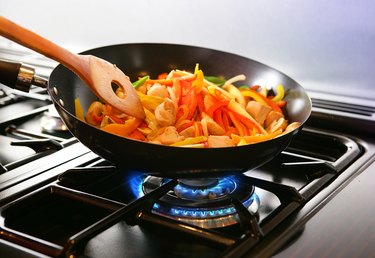A stroll down the cookware aisle may leave you with more questions than you had going into it. With so many different types of cookware, figuring out which is best and how they compare isn't always easy. Two types of cookware widely sold in the United States are nonstick and anodized. Whether you're a novice or a gourmet chef, understanding some of the differences between these popular types helps you make the best decision for your home kitchen.

Video of the Day
Nonstick Cookware
Nonstick surfaces came onto the cookware scene in the 1960s. Since then, nonstick cookware has garnered a huge share of the North American market, nearly 60 percent. Nonstick cookware has a coating that prevents food from sticking, which makes your time in the kitchen easier.
Video of the Day
Although controversial at times, nonstick coatings have been confirmed safe for human use by scientists from the Food and Drug Administration. Cookware without perfluorooctanoic acid (PFOA) is considered more environmentally friendly than those made with other nonstick coatings. Nonstick pans come in handy when cooking low-fat meals because you don't have to load the pan with grease or oil to keep the food from sticking.
Anodized Cookware
Anodized cookware, sometimes called hard anodized cookware, starts with an aluminum or aluminum alloy base, which is dipped into a chemical bath, then zapped with an electric current. The pan retains the great heat conduction of aluminum but has a much stronger protective layer than the original metal, making pots and pans resistant to corrosion, scratching and other damage. Anodized cookware offers even heat distribution and does not react to acidic foods. Most have heavy bases, providing balance to the pan on a stovetop and contributing to a long life for each pot.
Cooking Temperatures
Both types of cookware save energy because they effectively cook at lower temperatures than pans made of stainless steel, cast iron or aluminum alone. A setting of medium or lower is recommended for both types of cookware. Cooking at too high a temperature burns food in a nonstick pan, affecting the nonstick coating. In general, anodized cookware can handle a higher temperature than nonstick, although it's rarely necessary to crank up the heat too much for even cooking. Impatient cooks can ruin any kind of pan by using too high heat and leaving it untended on the stove.
Durability and Cleanup
Nonstick cookware requires a little TLC to avoid scratching the coating. Avoid any utensils that might scratch the layer of nonstick coating. Sharp metal utensils can scratch anodized cookware, as well. Even if your pans have a few minor scratches, they pose no safety threat and should keep working for years.
Both types of cookware make cleanup easier than other types of pots and pans. Nonabrasive plastic or nylon cleaning pads work well to wipe the surfaces clean. Metal scourers can scratch the surfaces of both types of cookware. Most manufacturers advise against putting nonstick or anodized cookware in an automatic dishwasher, even if they're considered dishwasher-safe.
Buying Decisions
Still not sure which type is best for you? Consider purchasing a single piece to decide if it meets your needs before investing in a huge set you may not like. Once you have a clear winner, buying a set is often more cost-effective than buying one pan or lid at a time. Cookware sets include several sizes and types of pans, such as saucepans or skillets, and are sold with a variety of lids and other accessories.